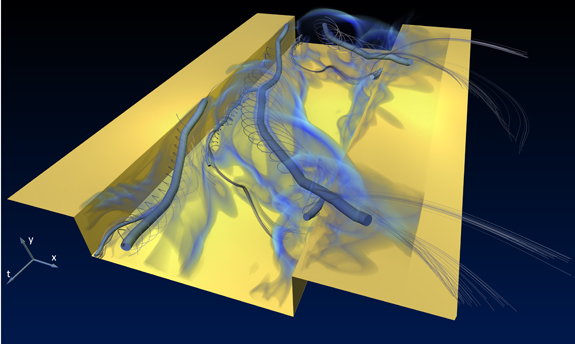Flow Over a Cavity
Jens Kasten
Ingrid Hotz
Hans-Christian Hege
Jan Reininghaus
Zuse-Institut Berlin
Berlin, Germany
Kilian Oberleithner
Technische Universität Berlin
Berlin, Germany
Bernd R. Noack
Institut Prime - CNRS
Université de Poitiers
Poitiers, France

Visualization of the vortex skeleton of the flow over a cavity.
The structures are extracted using extremal structures
of the acceleration field as a feature identifier.
We consider a numerical simulation of a weakly compressible 2D flow over a cavity (courtesy: M. Samimy). The flow over the cavity (yellow) is from left to right, the time is represented by the third dimension. Focus is placed on the temporal evolution of the vortices. These vortices (blue vortex cores) are identified as minima of the acceleration magnitude following the feature extraction concept of finite- time topology. The spiraling curves represent fluid particle paths in the vortical regions. The volumetric smoke-like regions indicate a range of large acceleration magnitudes. The vortices originate at the leading edge and move through the cavity over the trailing edge. The halo of each vortex consists of spiraling particles with large acceleration values.
This work is funded by the German Research Foundation (DFG): Emmy Noether Programm, SFB 557 and NO 258/2
References
Kasten et al., 2010, in Pascucci et al., Springer
Reporters and Editors
This image can be used freely by reporters so long as they credit all authors and their affiliations.
